| |
|
Educating our students about Israel
By Alan Rusonik
“We want a home in our country. It was given to us by the mercy of God. It is ours as registered in the archives of history…” (From “The BILU Manifesto," 1882).
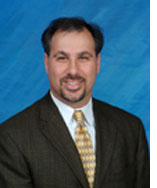 SAN DIEGO—The BILUIM were the first Jewish settlers to arrive in the Land of Israel as part of the modern “Return to Zion.” The BILUIM (plural for BILU) was an acronym made up of four Hebrew words from the Prophet Isaiah. The words in Hebrew are “Beit Ya’akov Lechu VeNelcha…” – “O house of Jacob: come let us walk…” (Isaiah 2:5). SAN DIEGO—The BILUIM were the first Jewish settlers to arrive in the Land of Israel as part of the modern “Return to Zion.” The BILUIM (plural for BILU) was an acronym made up of four Hebrew words from the Prophet Isaiah. The words in Hebrew are “Beit Ya’akov Lechu VeNelcha…” – “O house of Jacob: come let us walk…” (Isaiah 2:5).
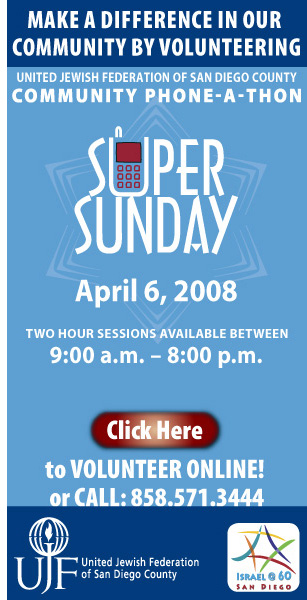 The BILUIM chose these words for a specific reason. Until the end of the 19th century, many Jews in Europe insisted that the Jewish people should wait patiently for the coming of the Messiah. At that time, the Messiah would gather the Jews from the four corners of the world and bring them to the Land of Israel. The BILUIM felt that they could no longer wait. They had to obey the call of their heart to go to the Land of Israel and make it livable so more Jews would come settle in the land. The BILUIM were wonderful role models for us, as they remind us of the need to take matters into our own hands, be it regarding the Land of Israel or simply to make our lives better. The BILUIM chose these words for a specific reason. Until the end of the 19th century, many Jews in Europe insisted that the Jewish people should wait patiently for the coming of the Messiah. At that time, the Messiah would gather the Jews from the four corners of the world and bring them to the Land of Israel. The BILUIM felt that they could no longer wait. They had to obey the call of their heart to go to the Land of Israel and make it livable so more Jews would come settle in the land. The BILUIM were wonderful role models for us, as they remind us of the need to take matters into our own hands, be it regarding the Land of Israel or simply to make our lives better.
We owe so much to the BILUIM and to the other pioneers who settled the Land of Israel. Yet today, over 120 years later and as we approach Israel’s 60th birthday, Israel continues to face existential threats and needs us to again take action.
In the same chapter of Isaiah (verse 3) the prophet states:
"Ki mi-Tzion tetze Torah u'Dvar Hashem meYerushalayim” “For out of Zion shall go forth Torah and the Word of Hashem from Jerusalem." Isaiah 2:3
As the teachers of Torah to the Jewish people, it is the responsibility of Jewish educators to remember that Torah emanates from Israel. Therefore, a strong, safe and secure Israel must be of the utmost importance. It is equally imperative that our students are knowledgeable, well versed and committed to the safety and security of Israel. As you will see throughout this newsletter, the AJE has an abundance of resources for Israel @ 60. I encourage each of us to use this teachable moment of Israel @ 60 to help our students grow in their knowledge of Israel. I urge each of us to re-commit ourselves to educate our students about Israel and to put Israel education at the forefront of our agenda.
. .
Monday, April 7 Jacob Goldberg Lecture: Iran versus Israel

Friday-Sunday, April 11-13 Mountain Chai~Big Boys Getaway
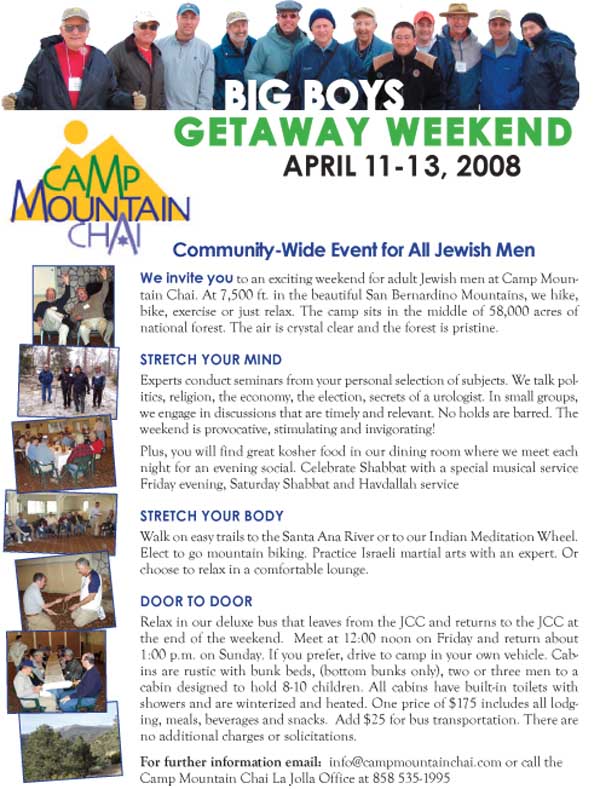
SUNDAY, APRIL 13 Beth Israel~Israel at 60 photo exhibit

Sunday, April 20 Beth Am~Second Night Seder
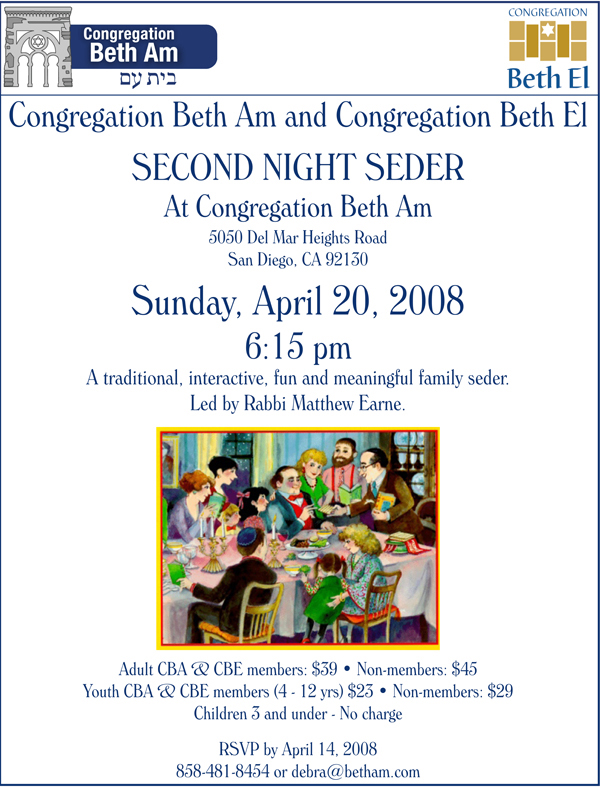
Wednesday, May 28 JFS~Ellen Saks lecture on mental illness
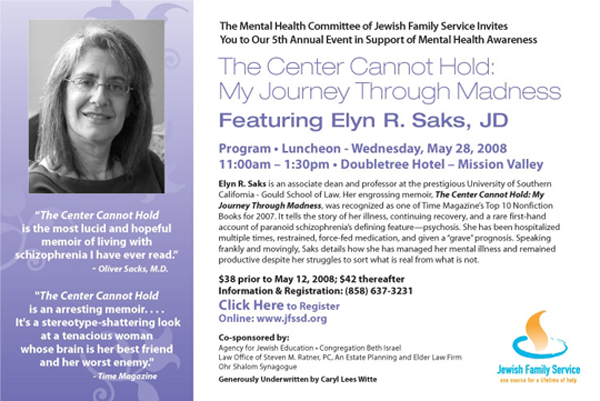

TORAH ON ONE FOOT
Lingering over seder: a sign of freedom
By Rabbi Leonard Rosenthal
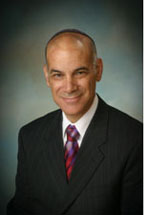 SAN DIEGO—At one time the dinner table was held sacred by most families. It was the one place that all family members gathered during the day. They joined not only to eat, but to share conversation about their lives and debate the events of the day. No matter what family members did before or after, they were sure to come together for the evening meal. SAN DIEGO—At one time the dinner table was held sacred by most families. It was the one place that all family members gathered during the day. They joined not only to eat, but to share conversation about their lives and debate the events of the day. No matter what family members did before or after, they were sure to come together for the evening meal.
Today it is common for many families never to eat together. Their schedules are so busy that kids often eat before their parents or everyone eats on their own, often sandwich in hand in front of the television. We are always in a rush and do not have time for such civilities as shared meals and dinner time conversation.
When the Israelites were leaving Egypt they were given strict instructions on how to consume the Pesach lamb they had just slaughtered: "This is how you shall eat it: your loins girded, your sandals on your feet, and your staff in your hand; and you shall eat it hurriedly..." (Ex. 12:11) The Israelites had to eat quickly because God was taking them out of Egypt that night. They had no time to spare as they gathered their meager belongings and prepared to flee from slavery to freedom.
Our Passover Sedarim are pointedly the opposite. We are not fleeing from Pharaoh but celebrating our freedom. We recline on pillows and leisurely eat a multi course meal. No one is forcing us to go out and labor and we are not escaping from a despot. We have the time and luxury to enjoy our meal, our conversation, our family, and our friends.
In the Passover Haggadah we read: "Now many are still enslaved. Next year may all be free!" Slavery is not only physical, it can be spiritual as well. Being in a rush all the time because we are over committed is also a form of slavery. We are allowing something external to have ultimate claim to our lives. Not being able to share dinner because everyone is always in a hurry is indicative of one living life of servitude rather than freedom.
Passover holds many powerful lessons for us. One of them is that we must free our souls, as well as our bodies of all that diminishes us as human beings. We must always retain first claim on our time and use it for those things we hold of value, rather than squander it on something else.
May the upcoming Passover holiday remind all of us to break the bonds of whatever still
Click here for easy-to-clip coupon; Product available at Ralphs in La Jolla; The Place in College area
|
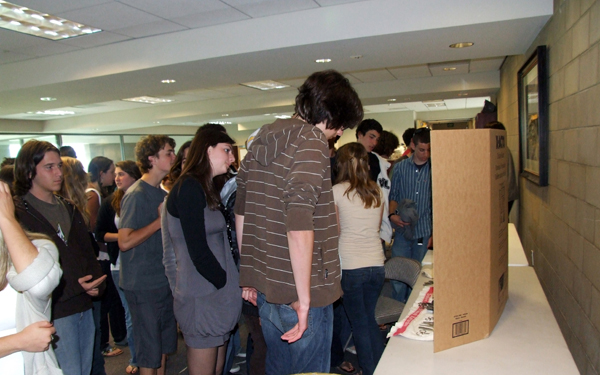
THE JEWISH CITIZEN
American Jewish POW, held by Nazis, brings history alive for SDJA students
By Donald H. Harrison
 SAN DIEGO—A year ago I had the pleasure of serving as a teaching assistant at San Diego State University in a course on American history. The first book that the professor had assigned to the class was an analysis of Ronald Reagan's presidency. "Ronald Reagan!" exclaimed my wife Nancy. "He's not history; he's current events." SAN DIEGO—A year ago I had the pleasure of serving as a teaching assistant at San Diego State University in a course on American history. The first book that the professor had assigned to the class was an analysis of Ronald Reagan's presidency. "Ronald Reagan!" exclaimed my wife Nancy. "He's not history; he's current events."
Indeed, so we thought, as I had covered Reagan when he was governor of California and occasionally during his presidency. How could anything that we lived through be "history?" But that's the point: happenings get transformed from "current events" to "history" depending on whether you've lived through them. If they occurred before you were born, they're history, pure and simple.
The students at the upper school of San Diego Jewish Academy were born during the 1990s, so for them World War II is the stuff of books, television series and movies—just like such other conflicts as the U.S. Civil War, the American Revolution, the War of the Roses, or the Roman Conquest of Jerusalem. That's why history teacher James Murphy wanted them to meet Sy Brenner, who not only is a World War II Army veteran, but is a Jew who was captured and imprisoned in Germany by the Nazi regime.
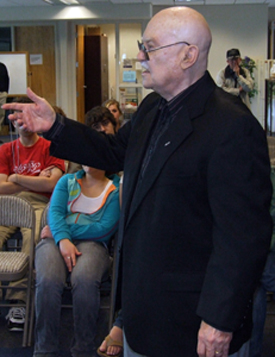 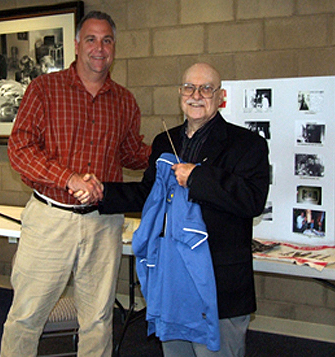
Brenner, who is now in his 80s, spoke for an hour to the class about his extraordinary wartime experiences after a French farm house to which he was running to take cover was pulverized by a shell from a German tank. The explosion threw him some 30 feet n the air, and when he landed unconscious, many members of his unit (2nd Battalion, 410th Infantry Regiment, 103rd Infantry Division, 7th Army) thought—and some reported—that he had been killed. However, when one American soldier saw that Brenner was still breathing he snapped off the lower portion of Brenner's dog tag—the part that told his blood type and his religion. Had the Germans seen the "H" for Hebrew on Brenner's tag, he might have been summarily executed.
Brenner said he does not know the identity of the soldier who thus saved him, or even how that person knew he was Jewish, but "I call him my Righteous Gentile." Along with other wounded prisoners, Brenner was marched for two weeks to a POW camp in Germany, after being warned that if any of them tried to escape or fell out, they would be shot. The marchers were given no food, no water. "We ate snow and we urinated in our pants—it was the only warmth we had—and they kept hitting us with their rifles."
There were no juvenile giggles when Brenner mentioned urinating in his pants. That's when I realized that he had captured the students' attention; history was beginning to come alive for them. This was a real person, not some character in a book, and he could easily be the grandfather--even the great-grandfather of any one of the students.
About 70 percent of the marchers got to Germany, Brenner said. Because he was a medic, he was assigned to a prisoners' clinic, where there were no doctors. A German officer told him he was expected to perform amputations and other surgeries, as required, and when he protested that he was not qualified for such tasks, he was informed by a Dutch POW who served as an interpreter, that in a prison camp, "you're qualified to do anything that man tells you to do."
Brenner still has nightmares about the first leg he amputated, recalling how grotesque it looked after he threw it into a bucket. He also has regular nightmares about a time, without any apparent reason, sadistic captors shut him into a closet for three days with a rotting corpse, the smell of the decay mixing with that of Brenner's own bodily wastes. He survived by getting his mouth close to the crack at the bottom of the door and sucking air from the outside.
Among the prisoners at the camp was a detachment of French soldiers who somehow managed to remain in touch with the French underground. Not trusting some people from their own unit, the Frenchmen asked Brenner if they could hold their clandestine meetings at the clinic. Brenner agreed. . Besides being the head of the medical clinic, Brenner had been appointed by his fellow prisoners as their spokesman—the man who, under the Geneva Accords, could carry prisoners' complaints to the commandant of the prison. Because many different people therefore could meet with Brenner without raising suspicions, he was recruited to become a spy. Several times a week, he was marched out his cell by some of the prison guards who were surreptitiously helping the underground—the war nearing its end, and Germany's defeat all but certain. The guards would take him out of the prison to the home of "The Lady."
She turned out to be the disaffected wife of a German general. She took Brenner down into her basement where they could hear Allied broadcasts over the radio. At certain times during the broadcast, the Allies would say a series of seemingly silly words—all of them coded messages for agents in the field. The Lady would tell Brenner which coded message was his to relay, and then by means of sign and countersign, he later repeated it to prisoners working with the underground. Brenner had no idea what the coded messages meant, but both he and The Lady put their lives at risk to make sure that the operatives received them.
Several times during his seven-month-long captivity, Brenner feared that the Germans had discovered he was Jewish and would put him to death. On several occasions, he said the Shm'a prayer fearing he was about to be shot. In particular he was terrified that an anti-Semite who had been in his unit stateside would reveal his secret to the Nazis. But the man never did.
Brenner ran out of time before he could tell the students the story of his liberation from the prison camp. When the final bell before the weekend sounded, I expected that many students would dash out of the auditoriuml. But Brenner, an unassuming man who walked right out of their history books, had captivated the interest of many students, who crowded up to a table where he had placed a display board of souvenirs and photographs from the most traumatic and memorable experiences of his life.


THE VIEW FROM JINSA
Why is the U.S. sanctioning the arming of Palestinians; who will be the beneficiary?
By Shoshana Bryen
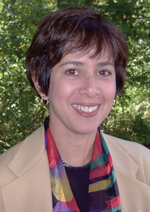 WASHINGTON, D.C.—A blurb from The Washington Post summarized the gifts bestowed by Secretary of State Rice on the Palestinian Authority (PA) at Israel's expense: WASHINGTON, D.C.—A blurb from The Washington Post summarized the gifts bestowed by Secretary of State Rice on the Palestinian Authority (PA) at Israel's expense:
A series of concrete steps by Israel aimed at improving the Palestinian economy. The agreement includes: removing 50 travel barriers in and around Jenin, Tulkarem, Kalkilya and Ramallah; dismantling one permanent roadblock; deploying 700 Jordanian-trained Palestinian police in Jenin and allowing them to take delivery of armored vehicles; raising the number of Palestinian businessmen allowed into Israel; increasing the number of work permits for Palestinian laborers; building new housing for Palestinians in 25 villages; connecting Palestinian villages to the Israeli power grid; and Israeli support for large-scale economic development programs and encouragement of foreign investment.
PA police will also receive ammunition, rubber bullets and night-vision equipment, as well as high-powered assault rifles.
Question: why do houses for Palestinians not upset the Administration, while houses for Jews - even in the capital of the Jewish people - drive them nuts? Palestinian villages can expand, but the U.S. Ambassador to Israel tells Israelis on a visit to Jerusalem that the U.S. is "concerned about building in Jerusalem" and "sometimes people need to move."
More important question: what did Israel get?
Most important question: what is the mission of the Palestinian police and why are we arming them if it isn't clear? One American-Israeli version is that the Palestinians will guard against and prevent terror directed at Israel. Do the Palestinians agree that they will arrest, imprison or even kill their cousins in order to protect the security of Israelis?
An Israeli source says the new U.S. security report compiled by General. Fraser concludes the PA is "failing to fight terrorism." According to the source, Fraser's report "slammed the PA for failing to arrest, interrogate and place terrorist suspects on trial... the PA occasionally carries out arrests... following pressure from Israel or the U.S. The arrested terrorists... are rarely interrogated or tried but instead are briefly detained." He is not the first American military officer to conclude that; might we hope is the last one asked?
Another version is that they will "make the streets of Nablus and Jenin safer from armed gangs," probably meaning that they are supposed to protect Fatah from Hamas. This was an abject failure in Gaza, and highly dubious now as Fatah's Al Aksa Martyrs Brigade (deemed a terrorist organization by the United States) has hundreds of members in the PA security services and presently threatens Abu Mazen himself on behalf of Hamas. Subquestion: Do we know which members of the Al Aksa MB are planning to protect Abu Mazen and which are threatening him? If not, why not and why are we giving them guns?
Last question: When Hamas threw Fatah out of Gaza during the civil war there in 2006, Hamas acquired important stores of military/police equipment from Fatah arsenals. What confidence does the United States or Israel have that Fatah will better protect its arsenal in the coming Hamas-Fatah civil war on the West Bank?

ADVENTURES IN SAN DIEGO HISTORY
Editor's Note: Here are more stories that were printed in the September 20, 1922 edition The San Diego Jewish Community News—a benchmark edition that outlined the history of Jewish organizations in San Diego. In this space, we will reprint all the stories on that theme that were printed in that edition. If you have historical topics about the San Diego Jewish community you would like us to explore, please e-mail your suggestions to editor Don Harrison at sdheritage@cox.net
A New-Comer’s Views
By Morris G. Straus
From The San Diego Jewish Community News, September 20, 1922, page 7
Speaking as one of the newer members of the Congregation Beth Israel, I believe that our greatest handicap is indifference on the part of many of our members. Probably in that we are much like other congregations and other organizations. It is easy to say, “Let George do it.” So long as most of the members sit back and allow the trustees and the rabbi to do all the work, so long shall we be a dead, and not a live organization.
Temple Beth Israel can and ought to be made the center of Jewish life and progress in San Diego. When a membership meeting is called, every member should feel it his duty to attend and to participate actively in the discussion of matters vital to the growth and welfare of the congregation.
We have a beautiful faith and a beautiful ritual, and family attendance at the Friday evening service ought to be an established habit, to be broken only for a good cause. All the wealth of the Jewish religion, history and literature may be yours for the asking. Rabbi Dubin is an earnest student and would be happy to comply with your requests for discussion of subjects interesting you.
There are many opportunities open to us. It is for us to demonstrate both to ourselves and to our non-Jewish fellow citizens, that we are upholding the dignity and the traditions of our faith, and that, individually, and as a body, we stand for the better things of life.
We need your help, the help of every fellow Jew in the constructive work that is to be done in San Diego.
The Congregation As I Knew It
By L.A. Blochman
From The San Diego Jewish Community News, September 20, 1922, page 7
Through the dim and hazy past stand forth fond memories that some times make us wish that we were young once more, and wonder if all of our vaunted progress is real, or even desirable. As we ponder on the days gone by, when San Diego was only a large village, and we reflect on Judaism as we then knew it, our feelings are commingled with pleasure and regrets. When we think of the leaders of the Jewish Community of those days forever past, all of them gone to the great beyond, all of them who worked untiringly and unselfishly for the good of Jewry, none of them asking or expecting gain or pay, all of them working for the benefit of all.
Those were the days of real Judaism. Those were the days when all of the Jews of San Diego were united by a bond that made them one great family. The sorrows and joys of anyone of them were shared by all. Then there were no orthodox, and no reform, no clans or sets, no Zionists, no cliques, no mutual admiration bunch, not even a Rabbi, but all were Jews, all were friends, everyone was ready and willing to help the other. Harmony prevailed and joy and contentment reigned—Oh! That those happy days might return once more. Those Purim parties where we danced the good old waltzes and polkas and after the dancing came the eats and such eats! The platters piled up with turkey and duck and chicken, and those salads, and the home-made cakes that everyone vied with the other to see who could make the best. Yes, those good old souls are gone, and their children, sad to think about, scattered and some even worshipping other gods. When memories come to them of the happy days of old, we wonder if some time regrets do not linger near.Then the holidays and the fast days! When the Jews of the town gathered together in some hall, and Joe Man{n}asse furnished his Torah and Marcus Schiller and Luis Mendelson read the prayers and A. Blochman, Simon Levi, Rudolph Schiller and others assisted, and year after year all of the Jews met together, some times in one hall and some times in another.
Then came the “boom” and the village grew into a town, and we dreamt of a Temple of our own. As usual, the Jewish women came to the front, and held a great fair. The Gentiles, as well as the Jews came forward with donations of funds and goods and the banks and wholesalers were solicited and made the building of our present Temple a possibility. That was thirty-five years ago, and a few a very few, of those original workers still belong to our congregation. And then through the effort of my Mother, a Jewish Sunday School was started. Then a Rabbi was secured and the Congregation progressed. Afterwards came hard times, alternated by good times, and the ups and downs of the Community were reflected in the congregation. One Rabbi succeeded another. Some times we had none. Our membership was drifting and transient, but the few old faithful and old reliables kept the organization together, and now as we look back at the Annual Jewish Charity Ball, which was one of the Social events of the City and how it was waited for by Jew and Gentile alike, and compare it with our present affairs, we are prone to ask, Have we Jews progressed? With all our petty jealousies, conceit and bickering, with our differences and separations, is the Judaism of San Diego the City, equal to the Judaism of San Diego the Village?
Our Temple
By Mark Schoenbrun
From The San Diego Jewish Community News, September 20, 1922, page 7
I have been a member of Temple Beth Israel since the year 1913, when I first came to San Diego to make my home. I found, on coming here, an energetic, though small congregation of earnest Jews, banded together for the welfare of their faith, endeavoring in every possible way to strengthen their influence, trying always to enlarge the scope of their work. Each year they —I might say, we, since I have had the honor to be one of the Board of Directors since 1915, have exerted our utmost efforts toward the upbuilding of the Temple, increasing our membership, adding facilities as best as we could for our Religious School, enhancing our choir, and otherwise making improvements in our building and our methods. Today we stand at a place where a new and modern Temple seems to be the ultimate and natural outcome of our aims and endeavors; and this I hope will materialize at no very distant time.
Temple Auxiliary
By Miss Clara Grossmayer
From The San Diego Jewish Community News, September 20, 1922, pages 7, 17
It was about thirty years ago, when the Jewish community of San Diego was mere handful, that the few Jewish mothers felt the need of a Sabbath School There was soon organized a Mothers’ Club, the object of which was the creation and upbuilding of the school.
The only charter members of the Club, now known as the Auxiliary, who are still residing in San Diego are MRs. A. Levi, Mrs. H. Wolf and Mrs. S. Jacobs.
The first teachers included: Mrs. Lesem, Mrs. A. Blochman (now deceased), Mrs. Herman Welisch (now of San Francisco), Miss Celita Mannasse and Miss Celia Schiller.
When the Congregation Beth Israel was formally organized and services were regularly conducted by the mebers, the scope of the Club was enlarged. While its most important work has from its inception to the present day been the fostering and development of the Sabbath School, it now undertook also to aid in the maintenance of a choir.
As the community increased in numbers, a Temple was built, a Rabbi engaged and the choir improved. The Sabbath school was turned over to the congregation that it might become an integral part of that body, but the Club as before devoted its funds and its best energies to the support of the school. It supplied the teachers and arranged for a board of visitors. Too much credit cannot be given for their persevering efforts and devotion to purpose, of both teachers and visitors.
The Club has always provided for the ever-increasing needs of the school, has given rewards to the children, and little appreciative gifts to the teachers. It must be noted that the teachers have always protested against gifts to themselves, asking that the money be used for the children. It is this spirit of unselfishness and helpfulness that has always characterized the relations between the school and the Club.
For the pleasure and encouragement of the children, there have been periodical outings and other entertainments. The Purim and Chanulka (sic) festivals are annual evens. These occasions have done much to cement friendship among the children and between the children and teachers.
The Auxiliary has each year the very great pleasure and satisfaction of witnessing the confirmation of the young people who have completed the course of training given in the Sabbath School. Always an impressive and touching ceremony, the service this year was marked by the simplicity and sincerity characteristic of Rabbi Dubin and his work. The congregation is a unit in feeling it to be a privilege to be under the leadership of this able, earnest young man. He and his wife have, with the whole-hearted support of the teachers, accomplished great things with the Sabbath School.
One of the enjoyable factors in the Auxiliary meetings have been the short but interesting talks given by Rabbi Dubin. The ladies appreciate his help.
An annual event not to be forgotten is the luncheon which takes the place of the regular January meeting. This usually brings out the full membership of the Club, including out-of-town members and ex-members. The luncheon this year was held at the Waldorf Hotel.
Several years ago the Club affiliated with the National Federation of Temple Sisterhoods. It found a change of name desirable. As there already existed a “Sisterhood” connected with the Orthodox Synagog {Tifereth Israel}, it was decided that the Mothers’ Club should be termed “The Ladies Auxiliary to Temple Beth Israel.”
During its early history it was the custom to hold the monthly meetings at the members’ homes, but since the completion of the Welfare Building on the grounds adjoining the Temple, all sessions have been held at this more convenient center. Here too have been given card parties, bazaars, and other entertainments that have served the double purpose of drawing members of the community more closely together and of adding to the funds in the treasury of the Auxiliary.
The largest undertaking of the organization has been the annual community Seder. The very considerable labor required for the preparation of this celebration of the traditional feast has each time been rewarded by a large attendance and corresponding financial returns. It is much to be regretted that the Welfare Building is too small to accommodate the number usually partaking of the Seder.
With the increased and still increasing membership, the Auxiliary found it possible to increase its monthly contribution to the temple and to make generous donations to the organ fund, the Hebrew Union College Dormitory fund and the Joint Distribution Committee fund.
It has had the great satisfaction of seeing a new organ installed in the Temple, of witnessing the steady growth of the Sabbath School in numbers and in interest, and of including in its own membership seventy of the progressive pubic spirited Jewish women of San Diego. For while, as its name implies, it is an adjunct of the Temple, the Auxiliary cordially welcomes to membership all women, both permanent and temporary residents, who are in sympathy with its purposes.
The Auxiliary has gained much through the attendance of the clever, interested and interesting women who are frequent San Diego visitors. They bring us new ideas and new inspirations; and in a greater degree than is achieved at national conventions, serve to foster intimate friendly relations with Jewish individuals and organizations in other cities.
The Auxiliary takes pride in the fact that the plan for a new organ originated within its ranks, Mrs. Herman Wolf being the prime mover, and Mrs. Simon Levi’s bequest of one hundred dollars being the largest single contribution.
Many of the prominent Jewish women have acted as president of the Auxiliary. Among them being Mrs. L.A. Blochman, Mrs. Adolph Levi, Miss Laura Schiller, Mrs. M. Schoenbrun, Mrs. Weinstock, Mrs. Jennie Marks, Mrs. Lesem, Mrs. Rosenfield, Mrs. Herman Wolf and the present incumbent, Mrs. Ancker.
The Auxiliary is looking forward to another year of renewed activity and greater usefulness.

Please click on the schools' ads to visit their respective websites


L.A. BEAT
Survivor Mitzvah Project brings help, caring to elderly Jews in Eastern Europe
By Cynthia Citron
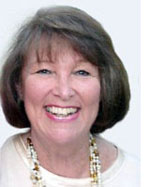 LOS ANGELES—A simple act of kindness and an unexpected detour changed Zane Buzby’s life forever. As well as the lives of some 850 very senior seniors living in eastern Europe and Russia. LOS ANGELES—A simple act of kindness and an unexpected detour changed Zane Buzby’s life forever. As well as the lives of some 850 very senior seniors living in eastern Europe and Russia.
The story begins in 2001, when Buzby decided to take a hiatus from her career as a producer and director at just about every major television network in Hollywood and make a sentimental journey to the small village in Russia from which her grandparents had emigrated. On the way, she stopped in Vilna to attend the first Litvak Congress. There she met Professor Dovid Katz, an American dialectician who had started the first Yiddish Program at Oxford and then become Academic Director of the Vilnius Yiddish Institute at Vilnius University, a position he still holds. Dr. Katz, upon learning that Buzby would be traveling through Lithuania and Belarus, asked her to make a “small detour” to visit some elderly Jews and bring them gifts of Yiddish newspapers, food, and small packets of U.S. dollars. This “small detour” set Buzby on the path to a gigantic new lifetime commitment.
The people that she met were Jews who had survived all the horrors of the 20th century: pogroms, virulent anti-Semitism, the First World War, the Russian Revolution, the Great Depression, the Second World War, ghettoization, rampant epidemics, the Holocaust, (“Lithuania alone killed 90 percent of their Jews before the Germans even arrived,” Buzby notes), the purges of Stalin, Siberian labor camps, Chernobyl… Now in their 80s and 90s, these remaining Jews had outlived their families, their children, and their friends. With no support, emotional or financial, they were eking out their lives in rundown shacks with no plumbing, no electricity, no running water, and no food except what they could grow themselves (mostly just potatoes). Many were ill or bed-ridden, despondent and alone. But because they had not suffered the ultimate horror, internment in Nazi concentration camps, they were not eligible for stipends or reparations from the German government and were living on the small allotments (sometimes as little as $16 a month) provided by their own governments in eastern Europe. “For them, the war never ended,” Buzby says.
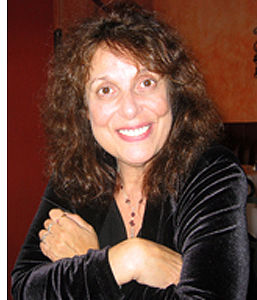 Haunted by what she had seen, and by the kindness and hospitality she had received during these visits, Buzby returned to Los Angeles and, with philanthropist S. Chic Wolk, set up the Survivor Mitzvah Project to funnel money to these new friends. “It’s incredible how much just a little money can buy,” she says. “Forty dollars a month can supply them with food and medicine and services. It can change their lives!” She mentions the $38 magnifying glass she sent to one man and his excited response, “I can read!” To another, a $200 operation that restored his sight. And to 87-year-old Galena Isakovna, money to bury her husband, whom she had tended faithfully for 13 years, during his long final illness. “Now I want to live a little,” she wrote in thanks. Haunted by what she had seen, and by the kindness and hospitality she had received during these visits, Buzby returned to Los Angeles and, with philanthropist S. Chic Wolk, set up the Survivor Mitzvah Project to funnel money to these new friends. “It’s incredible how much just a little money can buy,” she says. “Forty dollars a month can supply them with food and medicine and services. It can change their lives!” She mentions the $38 magnifying glass she sent to one man and his excited response, “I can read!” To another, a $200 operation that restored his sight. And to 87-year-old Galena Isakovna, money to bury her husband, whom she had tended faithfully for 13 years, during his long final illness. “Now I want to live a little,” she wrote in thanks.
The letters, in fact, are a major component of the Mitzvah Project. Because many of the survivors are ill or immobile or are the only Jews left of their families or in their village, the contact with the outside world brings them both friendship and hope.
“Hello,” Eva Semyonovna writes from Grodno, Belarus. “I received your letter. Thank you. I am sitting and crying that total strangers care about me. Thank you so much. You sent me half my pension. I do not write and read in English, however, my granddaughter can read English because she is studying medicine. She is 22 years old and a very good girl… Maybe you have some good Jewish boy for my granddaughter---she is nice and clever and she knows English well. When her exams are over she will continue learning English, but we need to pay $2 for this.
“The rabbi sent me a magazine,” she continues. “A very interesting one about our people who fought and were killed in 1941. In my country no one writes about them.”
And from Mogilyov Podolskiy, Ukraine, Mikhel writes: “A long time ago, before the war, (our town) was predominantly Jewish. A lot of Jews perished in the ghetto and in the concentration camps. There were 7,000 of us after the war. Now everybody is gone. Left for Israel, America, Germany. There are around 300 left. But we are trying to keep up the Jewish tradition. We rebuilt the synagogue. Every day a minyan gathers and we pray.
“There are 79 Holocaust survivors in our town. We created a Union, we have a place where we meet. We started a museum dedicated to Holocaust victims.
“Thank you very much for the gift. Nothing was stolen, I received it all. Stay healthy. I’m sending my best wishes to you and your loved ones. I’m wishing you to be happy, healthy and prosperous.”
The beneficiaries of the Survivor Mitzvah Project are eager to tell their life stories. Many have never told their stories before, but they remember them “like it was yesterday.” As Mera from Mariampol, Lithuania, remembers it, “Before the war started I lived in my town (Mariampol). As soon as the war started in 1941 I escaped deep into Russia. That’s how I survived that war.
“The fate of the Jews who were left in Mariampol was terrible. Those who did not save themselves were all shot. And were all put in one grave. All together, children, men, women and elders. Everybody was undressed, naked, and shot. Then the hole was covered with lime. Those who witnessed this told us that after that, for three days, the earth in this grave was raising up and down and there was moaning coming out of the grave. On that place there is a monument for all the victims. There were more than 8000 people in this mass grave.
“Today in my town there are only six Jews remaining.”
And in a footnote, Buzby has added: “Mera is the last Jew living in Mariampol who was born and raised there. She cares for her severely handicapped daughter without the benefit of any social services or medical assistance.”
To translate her letters into Russian and the responses from Russian to English, Buzby has found an avid volunteer, Dr.Sonia Kovitz, a self-styled “computer geek” who lives in Ohio. Kovitz was drawn to the project by her sister, Deborah Barkat, who lives in Los Angeles and met Buzby when she took a family samovar to Buzby to be repaired. Yes, that’s another of Buzby’s creative enthusiasms. In 1996 she discovered that the last brass store in New York was about to go out of business. At one time there had been as many as 400 such stores, but as Buzby explains, “the new immigrant Jews didn’t want their kids to be craftsmen,” so the processes of making and refurbishing these precious metal objects began to die out. And so Buzby bought up all the remaining stock of the nearly defunct store, taught herself the skills she needed, and set up an online store called the Lower East Side Restoration Project, which currently receives about 300,000 hits a month.
And finally, there is the Cyber Oasys, the Santa Monica-based company that has commissioned her and her husband to provide the first totally interactive, viewer-initiated programming for online and
mobile platforms. Her husband, Conan Berkeley, will produce the segments while Buzby (whose married name is, appropriately, Zane Buzby Berkeley) will direct. Their first project, “Stomp the Run” (a jargon-ish way to say “Seize the Day”) will be a comedy series that runs for two to four minutes a segment and allows viewers to determine the outcomes by clicking on a variety of choices.
Cyber Oasys also owns “The Spot”, a prize-winning original series that it launched on the web in 1995 and made available on Sprint PCS Vision Phones in 2004.
While all these projects are enough to keep any ten people busy, Buzby manages them all with aplomb. But her most urgent concern remains the Survivor Mitzvah Project. She is conscious of time passing, and the eventual passing of this sadly neglected generation. Her goal, she says, is “to bring help quickly and directly to these survivors so that they may live out their last years with some measure of comfort, support, and dignity.”
If you would like to participate in the Survivor Mitzvah Project by donating your fundraising skills, your letter-writing and translation skills, or your money, please contact Zane Buzby at zbuzby@survivormitzvah.org, or by logging onto www.survivormitzvah.org.
From the people you’ll be helping, a heartfelt “Spasebo!”

SAN DIEGO JEWISH WORLD THE WEEK IN REVIEW
Rabbi Michael Berk in La Jolla, California: All deaths by violence are not the same
Sherry Berlin in San Diego: A U.S. Civil War story—for Passover
Sheila Orysiek in San Diego: Chapter Two in the serialization of her novel, Reluctant Martyr
Rick Schwartz in San Diego: Seders connect family and community
And:
San Diego Builders of Israel, published by the United Jewish Federation of San Diego County in celebration of Israel's 60th year. Free download
From the Archives: Members of San Diego's Jewish community in 1922 looked at their past, present and future.
Shoshana Bryen in Washington, D.C.: Maliki's victory: Iran's big setback in Iraq
Donald H. Harrison in La Jolla, California: The thought at the Red Sea: Si, se puede!
Michelle Rizzi in San Diego: Like or hate it, Atonement garners 'Whys?'
Ira Sharkansky in Jerusalem: Violence, not settlements, blocks peace
San Diego Builders of Israel, published by the United Jewish Federation of San Diego County in celebration of Israel's 60th year. Free download
Wyman Brent in Vilnius, Lithuania: So, how will a nice Gentile boy help to restore Jewish learning in Lithuania?
Carol Davis in San Diego: Racism, anti-Semitism, sexism combine in lesbian love story at the Diversionary
Alex Grobman in Englewood, New Jersey: Rabbi Herbert Friedman, founder of Wexner Heritage Foundation, dies at 89
Donald H. Harrison in La Jolla, California: Sha'ar Hanegev citizens familiarize themselves with Reform Judaism
Eileen Wingard in San Diego: A Jew and Muslim to make music together
Donald H. Harrison in San Diego: Fictional Israeli P.I. fails 'memorable' test
Sheila Orysiek in San Diego: What music performance means
Gary Rotto in San Diego: My, how San Diego AIPAC has grown
Dorothea Shefer-Vanson in Mevasseret Zion, Israel: Britain's descent into anti-Semitism
From SDJA Student Quarterly, reviews by students:
Harry Doshay in San Diego: Anthology's linup thrills jazz fans
Alexa Katz in San Diego: Mesquite Restaurant: A gem in Scripps Ranch
Michelle Rizzi in Del Mar: Pannikin: The Anti-Starbucks
Shoshana Bryen in Washington, D.C. South America's growing terrorist threat
Cynthia Citron in Los Angeles: Production celebrates Albert E, musically
Kathi Diamant in San Diego: My quest to solve a literary mystery
Donald H. Harrison in San Diego: Sha'ar Hanegev seeks rocket-proof school
Rabbi Dow Marmur in Jerusalem: Some advantages to a peace with Syria
Sheila Orysiek in San Diego: Miller's needle: Revenge in a tailor shop
Link to previous editions
< BACK TO TOP
|
|

 —
—